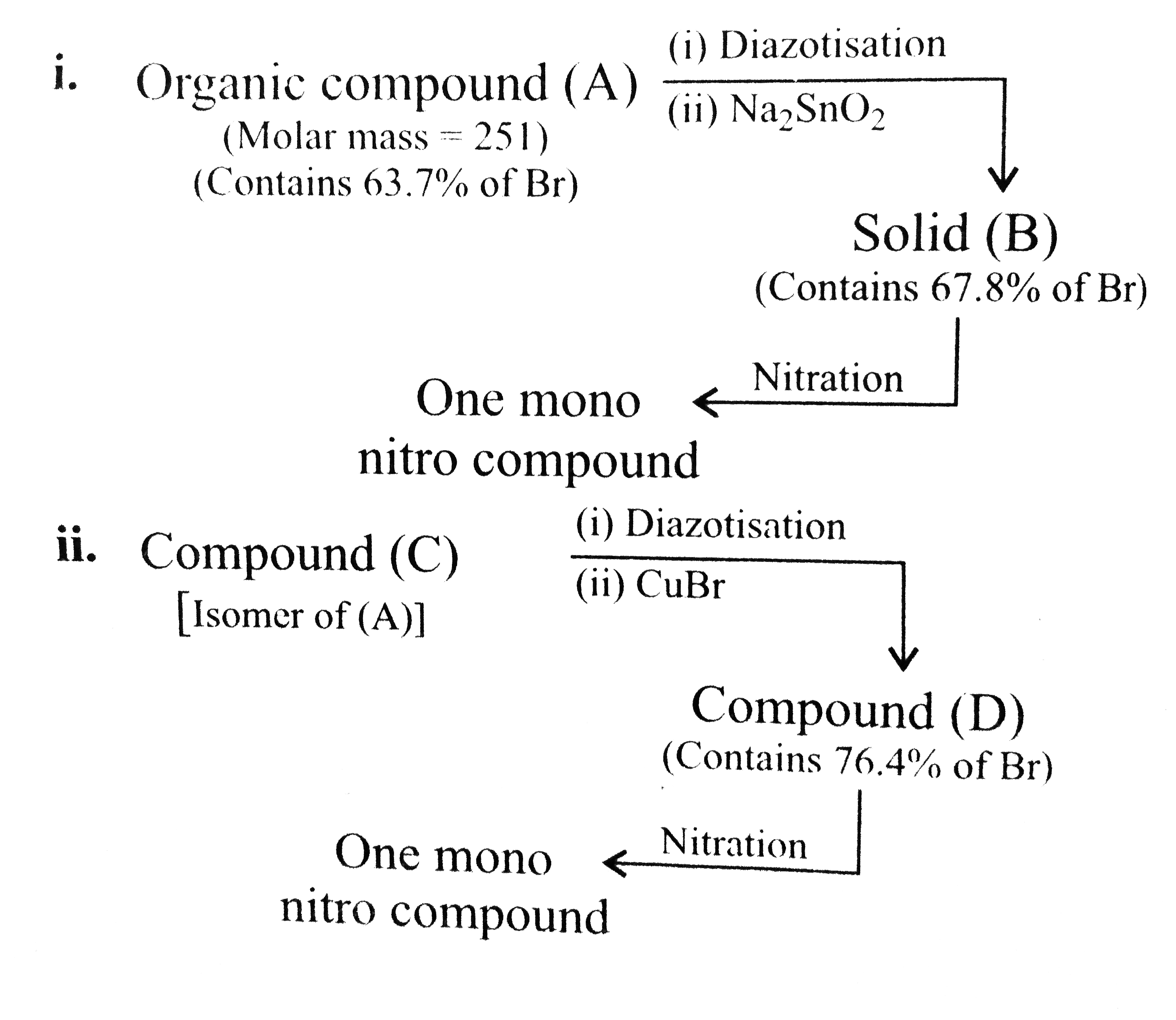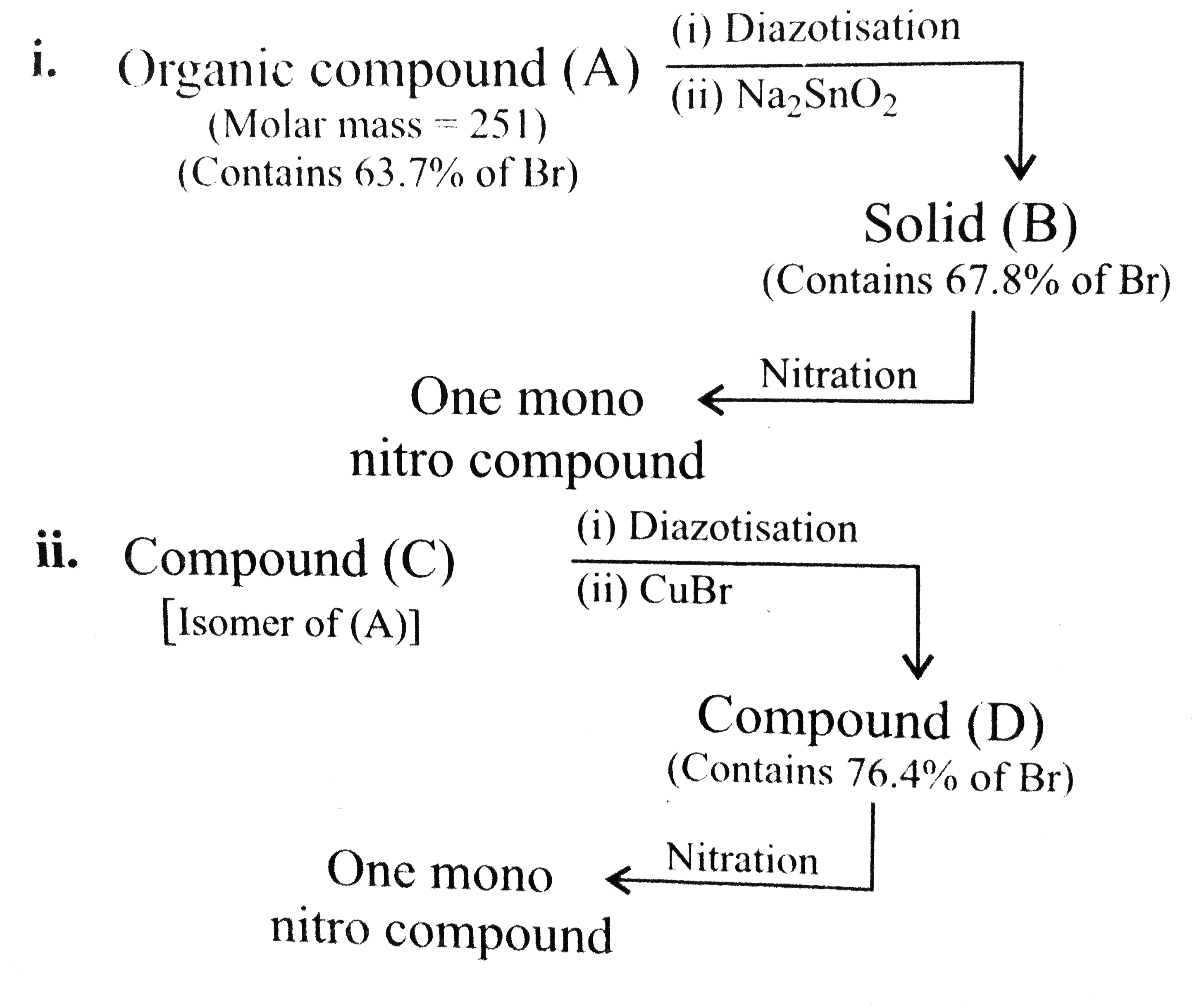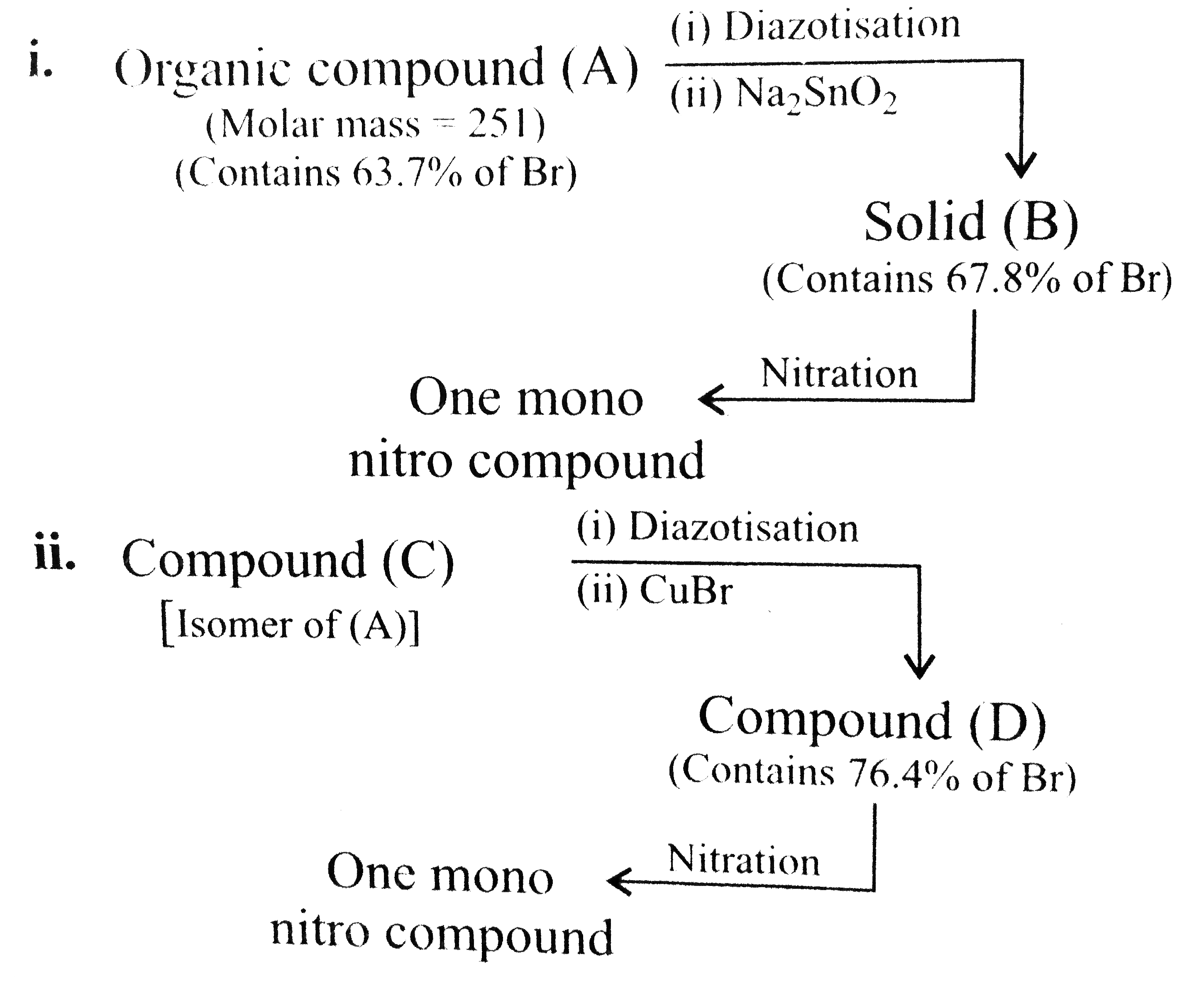Complete Solutions to Exercises Linked Comprehension of chapter ORGANIC COMPOUNDS WITH FUNCTIONAL GROUP of Class 12 book with complete answers and questions
| Class 12 | CHEMISTRY |
| Chapter | ORGANIC COMPOUNDS WITH FUNCTIONAL GROUP |
| CENGAGE CHEMISTRY | Exercises Linked Comprehension |
| Number Of Questions | 25 |
| Academic Year | 2023-24 |
(i)

Compound`(A)`is:View Solution(i)

(ii)
Compound`(C)`is:View Solution(i)

(ii)
Compound`(B)`is:View Solution(i)

(ii)
Compound`(D)`is:View SolutionHydrogen peroxide stored in wax-lined glass or plastic vessels in dark. True/False
01:28View SolutionWhat is water – gas shift reaction?
01:27View SolutionHard water does not produce lather with soap. True/False
01:44View SolutionT strength in volumes of a solution containing 30.36 g/l of H2O2 will be 5 volumes. True/False
01:51View SolutionExplain why cation are smaller and anions larger in radii than their parent atoms?
02:40View SolutionIs it possible to acidify borax solution?
01:14View SolutionWrite balanced equations to show hydrolysis reactions of `CO_3^2^- and HCO3–`.
01:21View SolutionBoric acid is a strong acid. True/False
01:29View SolutionWrite reaction when B(OH)3 is heated.
01:15View Solution`[A],[B],[C],[D],[E],[F]`,and `[G]` are amines,each of which forms a hydrochloride containing `32.42%`chloride.`[A],[B],[C]`and,`[D]`evole`N_(2)`on reaction with `HNO_(2)`but `[E],[F]`,and`[G]`donot.
Which of the following are`2^(@)`amines?View Solution`[A],[B],[C],[D],[E],[F]`,and `[G]` are amines,each of which forms a hydrochloride containing `32.42%`chloride.`[A],[B],[C]`and,`[D]`evole`N_(2)`on reaction with `HNO_(2)`but `[E],[F]`,and`[G]`donot.
If all the amines aree represented by the formula `R-NH_(2)`, the value of `R` in all the amines is:View Solution`[A],[B],[C],[D],[E],[F]`,and `[G]` are amines,each of which forms a hydrochloride containing `32.42%`chloride.`[A],[B],[C]`and,`[D]`evole`N_(2)`on reaction with `HNO_(2)`but `[E],[F]`,and`[G]`donot.
Which of the following does not represent the structure of (A),(B),(C), and (D)?View Solution`[A],[b],[C],[D],[E],[F]`,and[G] are amines,each of which forms a hydrochloride containing `32.42%`chloride.`[A],[B],[C]`and,[D]evole`N_(2)`on reaction with `HNO_(2)`but [E],[F],and[G]`do not.
Which of the following does not represent the structure of (E),)F), and (G)?View Solution`[A],[b],[C],[D],[E],[F]`,and[G] are amines,each of which forms a hydrochloride containing `32.42%`chloride.`[A],[B],[C]`and,[D]evole`N_(2)`on reaction with `HNO_(2)`but [E],[F],and[G]`do not.
Which of the following gives alcohol and evolves `N_(2)` gas?View Solution`[A],[b],[C],[D],[E],[F]`,and[G] are amines,each of which forms a hydrochloride containing `32.42%`chloride.`[A],[B],[C]`and,[D]evole`N_(2)`on reaction with `HNO_(2)`but [E],[F],and[G]`donot.
View SolutionA substance`(X)` contains `41.37% C,6.89% H.0.166gm` of `(X)` gave`NH_(3)` which was absorbed in`50ml` of `N//10 H_(2)SO_(4)`.The excess of acid required `30ml`of `N//10 NaOH` for neutralisation.`(X)`on treatment with`HNO_(2)`gave succinc acid `(X)`on heating lost`NH_(3)` to give(A).(A) reacts with`Br_(2)`and `NAOH` to give(B) containing `41.02%C,5.88%H`, and `11.96%N.(B)`on further treatment with`Br_(2)`and `NaOH`gives `(C)(3`-amino propanoic acid).(C)reats with`NHO_(2)` to give `beta`-hydroxy-propanoic acid.
Percentage of N is (X) is:View SolutionA substance`(X)` contains `41.37% C,6.89% H.0.166gm` of `(X)` gave`NH_(3)` which was absorbed in`50ml` of `N//10 H_(2)SO_(4)`.The excess of acid required `30ml`of `N//10 NaOH` for neutralisation.`(X)`on treatment with`HNO_(2)`gave succinc acid `(X)`on heating lost`NH_(3)` to give(A).(A) reacts with`Br_(2)`and `NAOH` to give(B) containing `41.02%C,5.88%H`, and `11.96%N.(B)`on further treatment with`Br_(2)`and `NaOH`gives `(C)(3`-amino propanoic acid).(C)reats with`NHO_(2)` to give `beta`-hydroxy-propanoic acid.
Compound (X) is:View SolutionA substance`(X)` contains `41.37% C,6.89% H.0.166gm` of `(X)` gave`NH_(3)` which was absorbed in`50ml` of `N//10 H_(2)SO_(4)`.The excess of acid required `30ml`of `N//10 NaOH` for neutralisation.`(X)`on treatment with`HNO_(2)`gave succinc acid `(X)`on heating lost`NH_(3)` to give(A).(A) reacts with`Br_(2)`and `NAOH` to give(B) containing `41.02%C,5.88%H`, and `11.96%N.(B)`on further treatment with`Br_(2)`and `NaOH`gives `(C)(3`-amino propanoic acid).(C)reats with`NHO_(2)` to give `beta`-hydroxy-propanoic acid.
Compound (A) is:View SolutionA substance`(X)` contains `41.37% C,6.89% H.0.166gm` of `(X)` gave`NH_(3)` which was absorbed in`50ml` of `N//10 H_(2)SO_(4)`.The excess of acid required `30ml`of `N//10 NaOH` for neutralisation.`(X)`on treatment with`HNO_(2)`gave succinc acid `(X)`on heating lost`NH_(3)` to give(A).(A) reacts with`Br_(2)`and `NAOH` to give(B) containing `41.02%C,5.88%H`, and `11.96%N.(B)`on further treatment with`Br_(2)`and `NaOH`gives `(C)(3`-amino propanoic acid).(C)reats with`NHO_(2)` to give `beta`-hydroxy-propanoic acid.
Compound (B) is:View SolutionA substance`(X)` contains `41.37% C,6.89% H.0.166gm` of `(X)` gave`NH_(3)` which was absorbed in`50ml` of `N//10 H_(2)SO_(4)`.The excess of acid required `30ml`of `N//10 NaOH` for neutralisation.`(X)`on treatment with`HNO_(2)`gave succinc acid `(X)`on heating lost`NH_(3)` to give(A).(A) reacts with`Br_(2)`and `NAOH` to give(B) containing `41.02%C,5.88%H`, and `11.96%N.(B)`on further treatment with`Br_(2)`and `NaOH`gives `(C)(3`-amino propanoic acid).(C)reats with`NHO_(2)` to give `beta`-hydroxy-propanoic acid.
Compound (C) is:View SolutionA substance`(X)` contains `41.37% C,6.89% H.0.166gm` of `(X)` gave`NH_(3)` which was absorbed in`50ml` of `N//10 H_(2)SO_(4)`.The excess of acid required `30ml`of `N//10 NaOH` for neutralisation.`(X)`on treatment with`HNO_(2)`gave succinc acid `(X)`on heating lost`NH_(3)` to give(A).(A) reacts with`Br_(2)`and `NAOH` to give(B) containing `41.02%C,5.88%H`, and `11.96%N.(B)`on further treatment with`Br_(2)`and `NaOH`gives `(C)(3`-amino propanoic acid).(C)reats with`NHO_(2)` to give `beta`-hydroxy-propanoic acid.
The conversion of (B) to (C) is called:View Solution
Exercises Linked Comprehension questions and complete solutions for chapter ORGANIC COMPOUNDS WITH FUNCTIONAL GROUP of CENGAGE CHEMISTRY (ENGLISH) of Class 12
All Exercises from CENGAGE CHEMISTRY Class 12 CHEMISTRY ORGANIC COMPOUNDS WITH FUNCTIONAL GROUP
- Archives Analytical And Descriptive
- Archives Assertion-Reasoning
- Archives Fill In The Blanks
- Archives Multiple Correct
- Archives Single Correct
- concept application 4
- Exercises Assertion And Reasoning
- Exercises Concept Application
- Exercises Linked Comprehension
- Exercises Multiple Correct
- Exercises Single Correct
- Exercises Subjective
- Illustration 15.1
- Solved Examples
